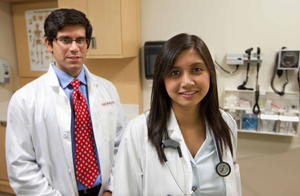September 24, 2012 - By Michelle Brandt

Med students Rishi Mediratta and Rachel Rizal are bringing Flu Crew services to homeless shelters, churches, free clinics and polling stations.
Medical student Rishi Mediratta vividly remembers the first time he gave someone a flu shot. "It was with a third-year medical student and I was very nervous having to stick a needle in someone," said the future physician. But luckily, thanks to the training he received as part of the school's student-run influenza-prevention program, "My first patient didn't even feel the needle."
Now more than a year later, Mediratta is co-director, along with fellow second-year medical student Rachel Rizal, of Flu Crew. Officially called the Medical Student Influenza Prevention Program, Flu Crew delivers no-cost vaccinations to people at Stanford and in the local community in an effort to reduce the burden of influenza and improve public health. It is the largest medical-school program of its kind in the country.
Flu Crew began in 2001, when Walter Newman, MD, a family physician and adjunct associate professor, taught several first-year Stanford medical students how to give flu shots. Since then, more than 25,000 no- or low-cost vaccinations have been administered by student volunteers.
Flu Crew participation is practically a rite of passage for incoming medical students these days: A majority of first-year students are involved in the program, including 75 percent of students in 2010 and 60 percent in 2011. At the beginning of the school year, students are taught about the pathophysiology and epidemiology of the influenza virus, which the Centers for Disease Control and Prevention estimates is associated with anywhere from 3,000 to 49,000 deaths annually in the United States. They also receive hands-on training on administering vaccines.
Last year, with vaccines and supplies donated by Vaden Health Center, Stanford University Occupational Health Center and the Santa Clara Public Health Department and support from numerous Stanford faculty and physicians, Flu Crew volunteers vaccinated more than 4,000 people, including more than 1,000 on campus. The students have brought their services to churches, homeless shelters and free clinics; in 2010, they offered free or low-cost vaccines to voters at two polling stations in Palo Alto and San Jose.
"What makes our program unique is that we deliver health care to where people eat, pray, live and work," said Rizal, who has a particularly fond memory of working last year with a low-income mom and her three young children at a church in San Jose.
"They didn't know much about vaccinations in general, and I brought them all in a circle and talked about the risks and benefits," she recalled. "I felt like I was educating an entire family and preventing them from becoming sick."
Both Rizal and Mediratta had done public-health projects before coming to Stanford. Rizal joined a World Health Organization project aimed at increasing hepatitis B vaccination among newborns in the Philippines, and Mediratta focused on preventive health services for Ethiopian children — and they consider the Flu Crew a "natural extension" of their previous work.
"The programs all have a similar goal of protecting a population," explained Mediratta, noting that 42 percent of vaccines administered in 2011 were provided to low-income individuals in Santa Clara County.
Faculty advisor Pat Fast, MD, PhD, an adjunct associate professor, counts the group's work with this population among its greatest achievements. "Last year, we vaccinated several hundred homeless individuals, a group that is at very high risk of complications from influenza — and a particular high point was immunizing women and their children at the battered women's shelter in San Jose," said Fast, who is also chief medical officer for the International AIDS Vaccine Initiative. "I'm sure this spares serious illness, possibly death, and also minimizes public expenditures for care."
Aside from providing a service to the community, the program benefits participating medical students by giving them early clinical exposure. First-year students don't always have the chance to work directly with patients, but here they are taught and able to practice how to greet, treat and even thank patients. "Even in a one-minute interaction, you're learning to build rapport," said Rizal. "It's a good position to be in as a first-year."
For some, the program also validates their decision to enter a profession that revolves around helping others. "Flu Crew is a weekly reminder of why I am in medical school," one participant told Mediratta and Rizal last year.
As for the future, Flu Crew is thinking big, with a goal of providing 6,000 vaccinations in the community this fall. The program is now partnering with Khan Academy, a non-profit that offers free educational materials, in developing an online training module for the outside world, and its leaders recently shared their training documents and instructions with the University of California-San Francisco, which now has a similar program. Flu Crew also is now integrated into Stanford's medical school curriculum, ensuring that all future students are trained in vaccination. For more information on Flu Crew and dates of upcoming vaccination events, please visit http://flu.stanford.edu/.
About Stanford Medicine
Stanford Medicine is an integrated academic health system comprising the Stanford School of Medicine and adult and pediatric health care delivery systems. Together, they harness the full potential of biomedicine through collaborative research, education and clinical care for patients. For more information, please visit med.stanford.edu.